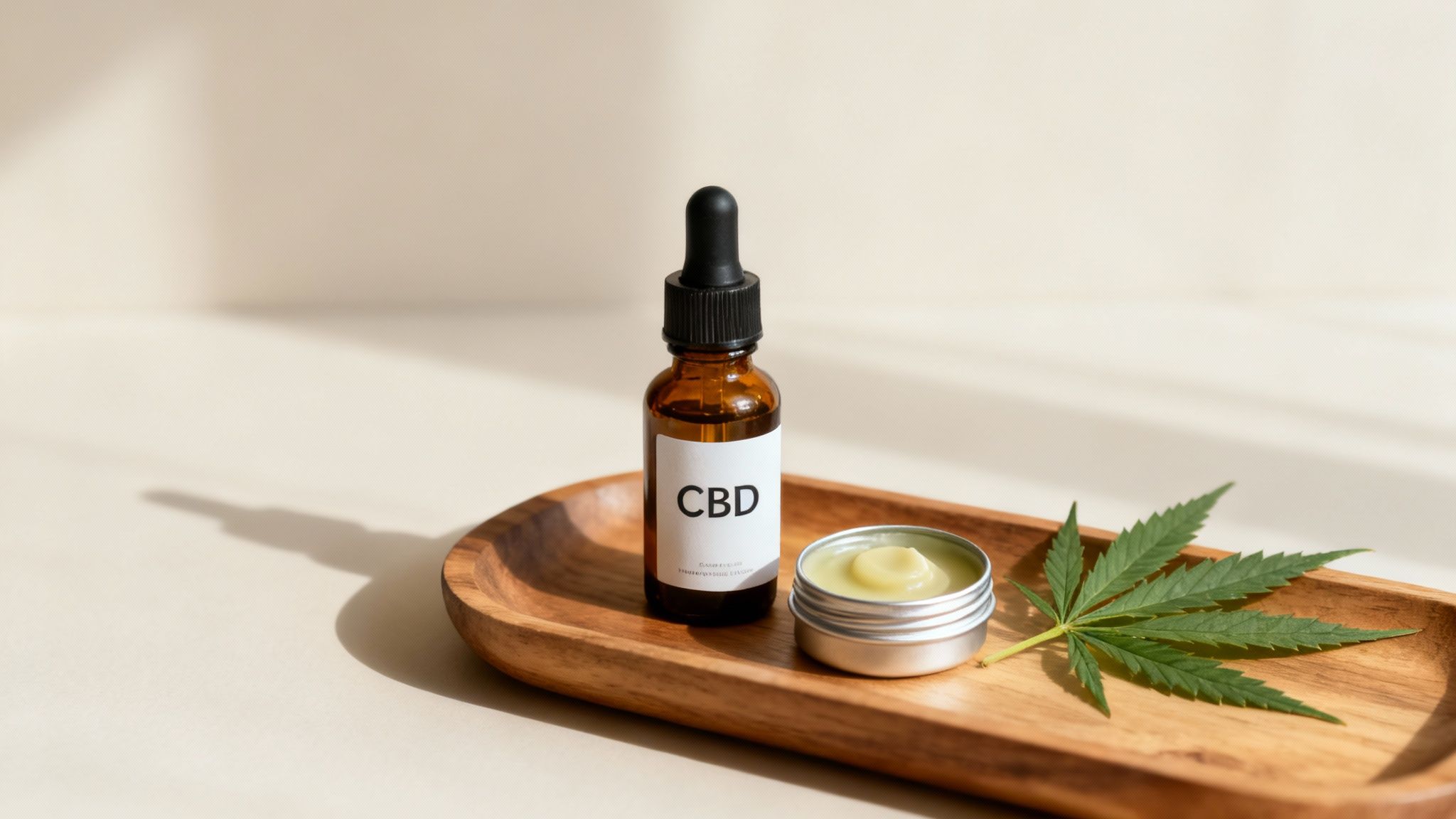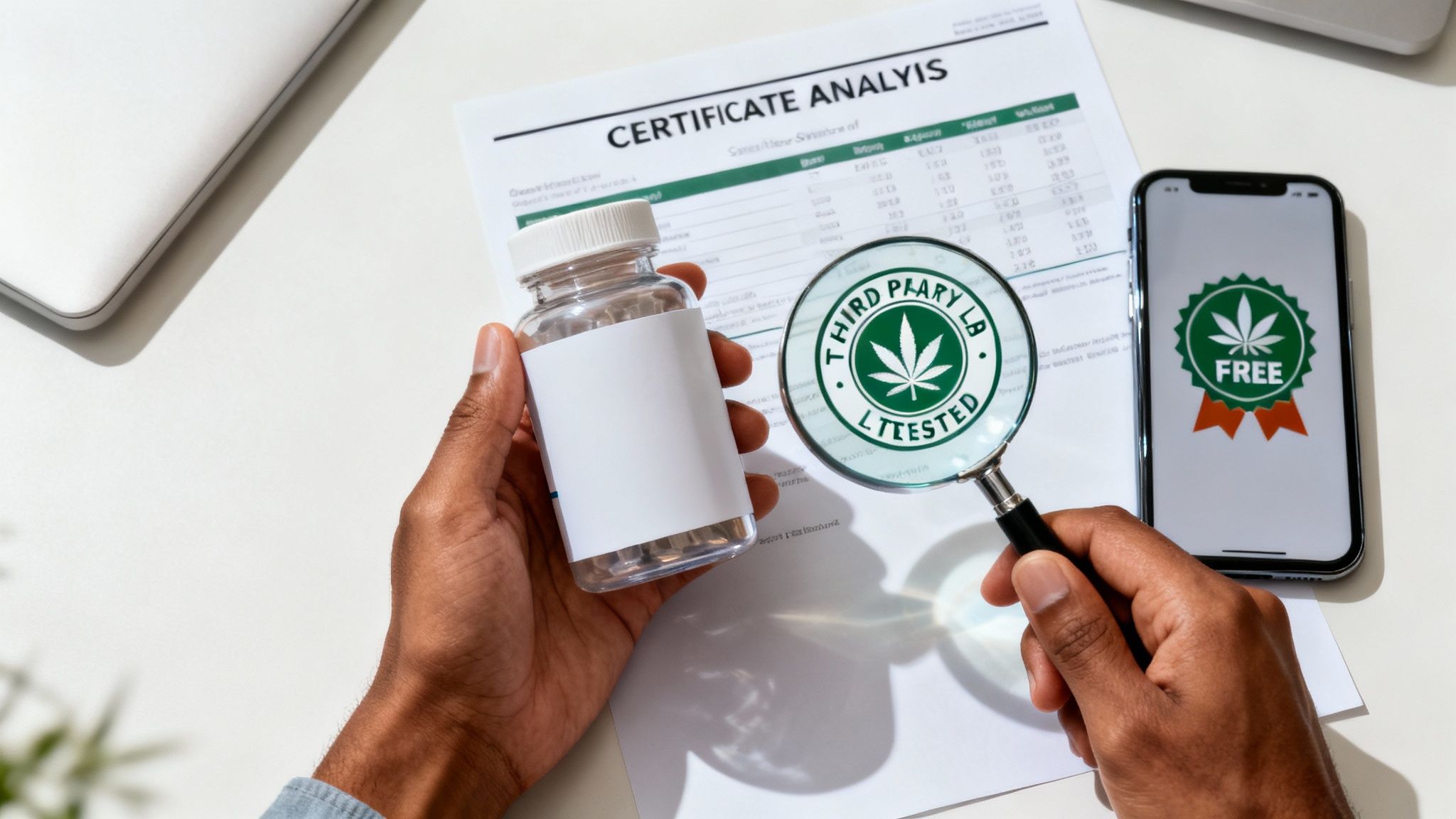If you're looking for something to help with stiff, achy joints, you’re in good company. From athletes trying to stay ahead of wear and tear to those of us just feeling the effects of a few too many birthdays, millions of people are turning to joint supplements. The goal isn't just a quick fix; it's about finding real, long-term support for the very framework that carries us through life.
The best joint supplements tend to feature a blend of well-researched ingredients like glucosamine, chondroitin, MSM, and Omega-3s, which work to protect cartilage and help manage inflammation. Now, newer options like high-quality CBD are also stepping into the spotlight, showing real promise for supporting comfort and mobility.
This guide is here to help you cut through all the marketing noise. We'll break down the key ingredients you'll find in the best joint supplements and look at what the science actually says about them. You won't just learn what to look for, but why it matters.
A Growing Market for Joint Health
The sheer demand for decent joint support is obvious when you look at the market. Here in the UK, the bone and joint health supplement scene isn't just growing—it's booming. Recent figures show revenue has hit an impressive USD 691.6 million, with forecasts suggesting it could climb to USD 1,420.0 million in the next few years. That's a huge surge, and it speaks volumes about how many of us are looking for proactive ways to stay active.
This growth has also brought a much wider range of options to the table, including botanicals and compounds like CBD, which are getting more and more attention for their wellness properties. As you explore the potential health benefits of CBD and other ingredients, getting to grips with the fundamentals is more important than ever.
Our aim is to give you the knowledge you need to go from a curious shopper to a confident buyer—someone who can spot quality, ignore the hype, and pick a supplement that genuinely fits their health goals. It all starts with understanding the building blocks of healthy joints.
Understanding the Building Blocks of Joint Health
To find the right joint supplement, you need to know what's actually in the bottle. Think of these ingredients as a highly specialised maintenance crew for your body, where each member has a specific and vital job. Getting past just recognising names on a label to understanding what they do is the first step towards making a smart choice for your joints.
This visual map shows how things like an active lifestyle and the natural ageing process drive the need for joint support.

It highlights a simple truth: whether you're a runner, a regular gym-goer, or just navigating the changes that come with time, your joints are always under demand. Let's break down the key players that help them stay in top shape.
To make things easier, here's a quick-reference table that summarises the main job of each key ingredient you'll often find in popular joint supplements.
Common Ingredients and Their Primary Roles
| Ingredient | Primary Role in Joint Health | Commonly Used For |
|---|---|---|
| Glucosamine & Chondroitin | Cartilage building and hydration | Maintaining cartilage structure and cushioning |
| MSM | Soft tissue support | Managing inflammation and discomfort |
| Collagen (Type II) | Structural framework | Providing strength and support to cartilage |
| Omega-3 Fatty Acids | Anti-inflammatory and lubrication | Reducing stiffness and soothing joints |
| Turmeric (Curcumin) | Potent anti-inflammatory | Natural relief from exercise-related aches |
This gives you a bird's-eye view, but let's dig into what each one really does for your body.
Glucosamine and Chondroitin: The Cartilage Protectors
Glucosamine and chondroitin are probably the most famous duo in the joint health world, and you'll often see them paired together in formulas. Imagine the cartilage in your joints is a durable, gel-like cushion stopping your bones from grinding against each other.
Glucosamine is one of the main building blocks for creating and repairing this crucial cartilage. It helps form the molecules that give cartilage its strength and resilience, a bit like a bricklayer using bricks to build a solid wall.
Chondroitin sulphate, on the other hand, acts like a sponge. It’s a natural part of our connective tissue that helps cartilage absorb and hold onto water. This hydration is vital for shock absorption and flexibility, making sure your joints can handle the bumps and knocks of daily life.
By working together, glucosamine provides the structural materials while chondroitin keeps the cushion plump and hydrated. This one-two punch is aimed at maintaining the integrity and function of your joint cartilage over the long term.
MSM: The Inflammation Soother
Methylsulfonylmethane, or MSM, is a sulphur-based compound that plays a different but equally important role. While glucosamine and chondroitin are all about cartilage structure, MSM is known for supporting the soft tissues—like ligaments and muscles—that surround the joints.
Its main strength is helping to manage inflammation and discomfort that comes with everyday activity. Think of it as the on-site team that calms down irritation after a hard day's work, which in turn makes movement more comfortable and stable. MSM also lends a hand in producing collagen, another vital component for joint health.
Collagen: The Structural Support
If cartilage is the cushion, then collagen is the scaffolding that holds everything together. It's the most abundant protein in your body, giving structure to your skin, bones, muscles, and all the connective tissues inside your joints.
Specifically, Type II collagen is the main protein found in cartilage. Taking a collagen supplement, particularly a form called undenatured Type II collagen (UC-II®), is thought to work with your body’s immune system to reduce inflammation and support the natural cartilage repair process. It provides the essential framework needed for strong, healthy joint tissue.
Omega-3 Fatty Acids: The Natural Lubricators
Omega-3 fatty acids, especially EPA (eicosapentaenoic acid) and DHA (docosahexaenoic acid), are widely praised for their powerful anti-inflammatory properties. They act almost like a natural lubricant for your joints, helping to ease stiffness and improve mobility.
You can get omega-3s from fatty fish like salmon and sardines, but a high-quality supplement offers a more concentrated dose. Their ability to help manage the body's inflammatory response makes them a cornerstone ingredient in many of the best joint supplements out there.
- EPA is primarily known for its role in managing inflammation.
- DHA is crucial for brain health but also contributes to joint comfort.
- Together, they provide a powerful combination against joint-related discomfort.
Turmeric and Curcumin: The Botanical Powerhouse
Finally, let's talk about botanicals, with turmeric leading the charge. Turmeric is that vibrant yellow spice that gives curry its distinctive colour, but its real power comes from an active compound called curcumin.
Curcumin is a potent natural anti-inflammatory. It works by helping to block certain pathways in the body that trigger inflammation, offering relief from the aches and pains that can come with an active life or age-related joint changes.
It is a safe and effective natural option for supporting joint function. But there's a catch: curcumin isn't easily absorbed on its own. That's why top-tier supplements often pair it with black pepper extract (piperine) to seriously boost its bioavailability. This ensures your body can actually use this powerful compound where it's needed most.
Understanding these key players—from the cartilage protectors to the inflammation soothers—gives you the knowledge to look at a supplement label and see not just a list of ingredients, but a team of specialists working to support your mobility and comfort.
What Science Says About Popular Joint Ingredients
When you start looking into joint supplements, it's easy to get lost in a sea of marketing claims versus what the science actually says. Plenty of ingredients show promise, but the level of solid evidence can vary wildly. Knowing what the clinical studies suggest is the key to choosing supplements based on real data, not just slick advertising.
It’s also worth remembering that research never stands still. What we know today might be updated tomorrow, but by looking at the current evidence, we can make much smarter choices for our joint health.
The Classics: Glucosamine and Chondroitin
For decades, glucosamine and chondroitin have been the headline acts in the joint support world, and for good reason. Countless studies have looked into how effective they are, especially when taken together. While the science often leans positive, the results can be a bit of a mixed bag.
A lot of the time, success seems to boil down to the specific formula and the dose used in the trial. Some research points to significant improvements in comfort and movement for people with stiff joints, while other studies find the effects are less clear-cut. This just goes to show why the quality and exact formulation of a supplement really matter.
The general idea is that these ingredients give your body the raw materials it needs to repair and maintain cartilage. They aren't a quick fix, but using them consistently over several months may offer real support for the long-term structure of your joints.
Ingredients with Strong Anti-Inflammatory Evidence
While some ingredients are all about building blocks, others are famous for their ability to help manage the body's inflammatory response. This is a massive piece of the puzzle for joint comfort, as out-of-control inflammation is a primary culprit behind stiffness and aches. If you'd like to dig deeper into this, you can learn more about the signs of chronic inflammation in our detailed guide.
Two ingredients, in particular, really stand out because of the robust science backing them up.
- Omega-3 Fatty Acids: The evidence for omega-3s, specifically EPA and DHA, is pretty substantial. Numerous clinical trials have shown they can help lower inflammatory markers in the body, which can mean less joint discomfort and better mobility.
- Curcumin (from Turmeric): Curcumin is another powerhouse with a ton of research behind it. Studies have found it can be effective at managing exercise-induced inflammation and soreness. It works by blocking certain inflammatory pathways, offering a natural route to supporting joint comfort. For it to work well, though, it needs to be paired with something like black pepper extract (piperine) to help your body absorb it.
Promising Research on Collagen
Collagen, particularly a form called Undenatured Type II Collagen (UC-II), has been getting a lot of attention lately, and the research is pretty compelling. Unlike other types of collagen that are just broken down into amino acids, UC-II is thought to work in a completely different way.
The science suggests it actually interacts with your immune system in the gut, triggering a process known as oral tolerance. In simple terms, this helps your body learn to recognise collagen as a "friendly" substance, which in turn can calm down the inflammatory attack on your own joint cartilage.
Studies have shown that small daily doses of UC-II can lead to major improvements in joint comfort, stiffness, and overall function—sometimes even outperforming the classic glucosamine and chondroitin combo. This makes it one of the most exciting ingredients on the scene for joint health.
Becoming a Critical Consumer
At the end of the day, the goal is to become a savvy customer who can see past the hype. Marketing will always put a positive spin on things, but it’s up to you to look a bit deeper.
Tips for Evaluating Claims:
- Check the Dosages: Make sure the product has enough of the key ingredients to actually do something. A tiny "sprinkle" of a popular ingredient is just for show.
- Look for Bioavailability: How does the formula make sure your body can absorb the ingredients? This is a huge deal for compounds like curcumin.
- Seek Third-Party Testing: Good brands aren't afraid to prove what's in their products. They'll use independent labs to verify ingredient levels and check for purity.
By sticking to ingredients with solid scientific backing and questioning any bold claims that seem too good to be true, you can navigate the supplement aisle with confidence. This approach helps you pick high-quality products that are designed to deliver genuine, evidence-based support for your joints.
Exploring CBD as a Modern Approach to Joint Support

As our understanding of natural wellness grows, so does the list of ingredients finding their way into joint supplements. One of the most talked-about additions is Cannabidiol, or CBD, which offers a completely fresh angle on supporting joint comfort and staying active.
Let's get one thing straight from the start: CBD is not intoxicating. It's a natural compound pulled from the hemp plant, totally separate from THC—the bit responsible for the "high" in cannabis. This distinction is vital for anyone looking at CBD for its wellness benefits.
CBD gets to work by interacting with the body's Endocannabinoid System (ECS). You can think of the ECS as a sort of master control panel, helping to keep everything in balance, from your mood and sleep patterns to how your body responds to discomfort. CBD helps support this system, which in turn can influence how our bodies handle inflammation and perceive aches.
How CBD Supports Joint Health
Instead of seeing CBD as a magic bullet, it’s much more helpful to view it as a supportive tool. Its main job when it comes to joint health is helping the ECS to soothe the body's inflammatory response. After all, when joints feel stiff and achy, it's often down to inflammation from daily life or a good workout.
By lending a hand to the ECS, CBD can help calm this response down, making movement feel that bit easier and more comfortable. This is what makes it such a great complementary ingredient, working alongside the likes of glucosamine to create a more well-rounded support system. The aim isn't to just mask the problem, but to help the body manage it more effectively right at the source.
CBD’s value lies in its ability to support the body's natural balancing act. By interacting with the endocannabinoid system, it helps manage the inflammatory responses that can lead to joint stiffness and discomfort, promoting greater ease of movement.
For those curious about how this all applies to specific joint conditions, our article on how CBD oil can help with arthritis takes a much deeper dive into the mechanics.
Finding the Right CBD Format for You
One of the best things about CBD is just how versatile it is. It comes in a range of formats, so you can pick the delivery method that fits neatly into your lifestyle. This flexibility is a big reason it's fast becoming a go-to for those looking to support their joints.
Here are the most common formats people turn to:
- CBD Oils and Tinctures: You take these orally, usually by popping a few drops under your tongue. This method gets the CBD into your bloodstream fairly quickly, offering support for your whole system. It's a solid choice for consistent, long-term use.
- CBD Topicals and Balms: These are applied directly onto the skin over a specific joint, like a knee or shoulder. The CBD is absorbed right where you put it, offering targeted relief exactly where you need it. This makes topicals perfect for tackling discomfort after a long day on your feet.
Many people find a two-pronged approach works wonders. Using a daily CBD oil provides that foundational, all-over support, while a topical balm is perfect for giving a particular joint some on-the-spot attention when it's feeling sore.
Quality and Safety in CBD Products
The boom in CBD's popularity has flooded the market, which means quality control has never been more important. When you're picking out a CBD product for joint support, transparency and safety should be at the very top of your list, especially here in the UK.
Always look for products that are third-party lab tested. This simply means an independent lab has checked the product's CBD content and, crucially, confirmed it's free from THC and any nasty contaminants like pesticides or heavy metals. Good brands will make these lab reports—often called a Certificate of Analysis (CoA)—easy for you to find.
Choosing products made right here in the UK also gives you peace of mind that they stick to strict regulatory standards. A commitment to quality, backed up by transparent testing, is the hallmark of a CBD brand you can trust. It’s your guarantee that you’re getting a safe, effective, and compliant product to help you on your joint health journey.
How to Read Labels and Identify High-Quality Supplements

Stepping into the supplement aisle or browsing online can feel like you’re trying to decipher a secret code. With so many bottles making bold claims, how do you sort the genuinely effective products from the cleverly marketed duds? The key is learning to read the label like an expert.
Think of a product label as its CV. It should tell you everything you need to know about what's inside, from the active ingredients right down to the manufacturing standards. A transparent, high-quality brand will lay it all out clearly, while a less reputable one might hide behind vague language or missing information.
As the UK market for supplements grows, especially online, knowing how to vet products is more important than ever. You can read more about these UK market trends to see just how big the industry is becoming. This knowledge empowers you to choose supplements that are not just effective, but safe.
Decode the Supplement Facts Panel
The very first place to look is the Supplement Facts panel. This is the nutritional information box, usually on the back, and it's where the real story is told. It’s more than just a list; it’s a detailed breakdown of what you're actually getting in each serving.
Here’s what to zoom in on:
- Serving Size: This is critical. All the amounts listed are per serving, so you need to check if a serving is one capsule or three. This simple detail completely changes how long a bottle will last and the true daily cost.
- Amount Per Serving: This column tells you the exact dose of each active ingredient. Be wary of vague terms like "proprietary blend," as they can be a red flag used to hide the precise amounts of key components.
- Ingredient Form: Look for specific, high-quality forms of ingredients. For example, some studies suggest glucosamine sulphate is more effective than glucosamine hydrochloride. For turmeric, you want to see a standardised curcumin extract, ideally paired with black pepper extract (piperine) to help your body absorb it.
The Non-Negotiable Third-Party Lab Test
In the UK supplement world, third-party testing isn't a luxury—it's an absolute necessity for any brand you decide to trust. This simply means an independent, unaffiliated laboratory has checked the product to make sure it meets specific quality standards. It’s the ultimate mark of transparency and accountability.
A third-party lab test is your guarantee that what's on the label is actually what's in the bottle. It confirms ingredient potency (does it have the advertised dose?) and purity (is it free from harmful contaminants like heavy metals, pesticides, or microbes?).
For CBD products, this is even more crucial. Independent testing verifies the CBD content and, importantly, confirms that the product is THC-free, which is a legal and safety requirement here in the UK. Good brands make these reports, often called Certificates of Analysis (CoAs), easy to find. You can see an example of how we provide full transparency by exploring our CBD testing certificates for every single batch.
Choosing the Right Formulation for You
Joint supplements come in all sorts of different forms, and the best one for you often comes down to personal preference and your daily routine. Each format has its own set of advantages.
Common Supplement Formats:
- Capsules and Tablets: These are the most common for a reason. They offer precise, pre-measured doses, are easy to carry around, and are generally tasteless.
- Powders: Often more cost-effective, powders can be mixed into water, smoothies, or food. This is a great option for people who hate swallowing pills or want to combine multiple supplements easily.
- Liquids and Gels: These are absorbed quickly by the body and can be a good choice for those with sensitive digestion. They offer an easy-to-take alternative to solid pills.
- Topical Balms (for CBD): Applied directly to the skin, these provide targeted support to specific areas. They work locally without entering your bloodstream, which is ideal for zeroing in on a particular joint.
By building a mental checklist—checking the facts panel, demanding third-party tests, and picking a format that suits you—you can navigate the market with confidence. This disciplined approach ensures you invest in a quality product that is safe, accurately labelled, and genuinely capable of supporting your joint health.
Got Questions About Joint Supplements? We’ve Got Answers.
Starting any new supplement is bound to bring up a few questions. When you're trying to find the right support for your joints, it’s completely normal to wonder about timing, safety, and what you should expect. Let's clear up some of the most common queries so you can feel confident about looking after your joint health.
How Long Does It Take for Joint Supplements to Work?
Patience is the name of the game here. Unlike a painkiller that just masks the discomfort for a few hours, joint supplements are designed to work from the inside out, gradually nourishing and supporting the very structures of your joints.
Most people start to feel a subtle shift—maybe a little less stiffness in the morning or more ease during a walk—within 4 to 8 weeks of taking them consistently every day. While some ingredients, like turmeric, might offer noticeable benefits a bit sooner, the building blocks like glucosamine and collagen need time to actually be integrated into your cartilage and tissues.
For the best shot at seeing results, stick to the recommended daily dose and give the product a fair trial of at least two or three months before you decide how it's working for you.
Can I Take Multiple Joint Supplements at the Same Time?
Combining supplements can definitely be a smart move, but it needs a bit of a strategy rather than just throwing more pills into the mix. Many of the best formulas on the market are already blended to be an all-in-one solution, so adding extra single-ingredient supplements could just be a waste of money.
That said, a well-thought-out combination can offer layered support. For example, you might pair a foundational supplement containing glucosamine and chondroitin with something complementary, like Omega-3s or CBD, to tackle things from a different angle.
Before you start mixing and matching supplements, it's always a good idea to have a chat with your doctor or a qualified healthcare professional. This is especially important if you take other medications. They can help you sidestep any potential interactions and build a routine that’s safe and right for your specific needs.
Are There Any Side Effects I Should Be Aware Of?
For the most part, the ingredients you’ll find in quality joint supplements are very well-tolerated. If anything, some people might experience a bit of mild digestive upset, like gas or bloating, especially when they first start taking glucosamine and chondroitin. Taking your supplements with a meal usually helps to settle things down.
It’s also crucial to check the source of the ingredients if you have any allergies. For instance, if you're allergic to shellfish, you’ll need to make sure your glucosamine comes from a vegetarian source.
To play it safe, always begin with the dose recommended on the label. And stick to products from brands that are open about their quality testing—this gives you peace of mind that what you're taking is pure and free from any unwanted contaminants.
What Is the Difference Between a Joint Balm and an Oral Supplement?
This is a great question, because they work in two totally different—but very complementary—ways.
-
Oral Supplements (Oils, Capsules, Gummies): You swallow these, and they work systemically. That means they travel through your bloodstream to deliver support from within. Think of them as your long-term maintenance crew, delivering key nutrients to nourish cartilage and manage inflammation throughout your entire body.
-
Topical Balms and Creams: You apply these directly to the skin over a specific trouble spot, like a sore knee or an achy shoulder. The active ingredients, such as CBD, are absorbed through the skin to provide targeted, localised relief right where you feel it most.
Many people find the most effective approach is to use both. The oral supplement provides that daily, foundational support for overall joint health, while a topical balm offers on-the-spot attention for those moments when discomfort flares up. It's a dual-action strategy that covers all the bases, supporting your joints from the inside and the outside.
At SMOKO CBD, we focus on providing high-quality, lab-tested CBD products made in the UK to support your wellness journey. Explore our range of CBD oils and topical balms to find the right fit for your joint care routine. Discover more at https://smokocbd.com.









